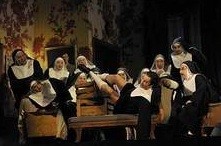Le Comte d'Ory Seduces Our Gal in Zurich
Camareno, Bartoli and Olvera Scintillate at the Opernhaus
By: Susan Hall - Jan 13, 2012
Le Comte D’Ory
by Gioachino Rossini
Opernhaus Zurich
Conducted by Muhai Tang
Zurich, Switzerland
January 11, 2012
Featuring Javier Camarena, Cecilia Bartoli, Rebeca Olvera
Le Comte d’Ory is having a resurgence, and the new production in Zurich shows us why. When it first opened in Paris almost two hundred years ago critics said Le Comte d’Ory was a mess, too vaudeville, and too much of a pastiche of Rossini’s previous work. Advance reports suggested that the new opera would unthinkably include a sleepwalker almost nude in a nightgown and walking barefoot like La Sonnambula.
Mashing up Rossini’s tribute for the coronation of Charles X, and a one act vaudeville play by prolific Eugene Scribe and Charles Gaspard Delestre Poirson, was thought to be a bad idea. Who could be interested in the exploits of a libidinous young nobleman and his band of knights worming their way into a convent during the Crusades?
Audiences have always loved the opera, although the music, unconventional for the comic opera form of the time, disturbed. Popular short lyric numbers and spoken dialogue had been unconventionally expanded into highly developed arias and choruses accompanied by recitative. We are the lucky beneficiaries of these moving and delightful advances.
Mosha Leiser and Patrice Caurier created the new production. Leiser and Patrice always work as a team, which includes Christian Fenouillat (sets), Agostino Cavalca (costumes) and Christophe Forey (lighting). Regular collaboration, like the John Adams/Peter Sellars group, means no ego trips and “fights and arguments take place before the rehearsals begin.” Leiser/Caurier’s first step is to study the score. They work from the inside with the performers, drawing each singer out with a general vision in mind.
At the trashy end of town, Le Comte has set up as a blind hermit who can heal. Javier Camarena as d’Ory in disguise enters tapping a stick to guide him and small black sunglasses to suggest eyes that do not see. We know they do, because the hermit trembles with excitement every time he lays his eyes on a girl or woman. Current dress suggests that the war in which the men of the town have left to fight is in the Middle East, ominously reflecting a world that does not change much in its focus on an area where civilization was once forged and where it well may end.
Such gloomy thoughts are quickly cast aside, however, when 20 women enter the hermit’s camper, like a clown’s circus car. The camper shakes and trembles with earthquake force. As the disheveled ladies emerge, tugging up their panties and stockings, readjusting hats and skirts, we know that the hermit is an exceptionally virile man who causes after shocks.
The Count sets his heart on a local Countess suffering a malady, which turns out to be sexual deprivation because all the men are away at war. His page Isolier is truly in love with the Countess, but it is the hermit who lures her into his ‘curing space’ in the trailer. The side and top of the trailer fold open to reveal lush red cushions in a bordello interior.
The second Act takes place in the presumably protected zone of a convent, to which the Countess and other women have retired for protection. D'Ory gets the idea of dressing as journeying nuns from Isolier who plans to enter the convent as a pilgrim. Camarena and his troops are physical actors who prance and dance to the blissful Rossini tunes.
Camerena, who was a wonderful Count Almaviva at the Metropolitan Opera this fall in Il Barbiere di Sivilgia, was even stronger here in Zurich. He took his runs easily and reached those glorious high C’s. His tone is edged with a subtle steel, which works very well in Rossini.
Cecilia Bartoli who sang the Countess with incomparable charm and nuance is seldom in the States these days, and it is surely worth a trip to hear her. Bartoli has a lively and vivacious stage presence. Her lyric voice is unrestrained and colorful, putting to marvelous effect elaborate roulades, pointed coloratura and even an effortless legato. In the smallest detail her vocal virtuosity is compelling, all in the interest of story telling which draws the listener in. The role of the Countess is so well served.
Young Mexican mezzo Rebeca Olvera played the page valiantly seeking his love. Her voice is true and fresh and, although she does not get solo parts, in duets and trios Olvera shone with her stage partners. Impetuous and yet passionate, you couldn’t help rooting for her success, even in the face of fake nuns and pilgrims trooping.
Singing the tutor, Ugo Guagkuardi had a particularly delicious way of shaping his decorations to speak the message. Oliver Widmer as d’Ory’s friend and assistant and Liliana Nikiteanu and Teresa Sedimair round out a first-rate cast.
The production is impeccable. But that does not mean that every "i" dotted and every "t" crossed makes the show in the least boring. The stage direction, the movement and gestures of the singers are perfectly tuned to the music. With Bartoli, Camarena and Olvera on stage you could close your eyes and feel what is going on, the best test of an opera’s success.
Muhai Tang conducted with a fresh and newly minted feel. Leiser and Caurier have brought humor and sex to an opera that is about humor and sex. No need for Hamletian plays within a plays to distract. A traveling hermit in a trashy camp and male nuns invading a women’s stronghold are plenty enough background for Rossini’s glorious music. The Zurich production succeeds with admirable fun and beauty.






